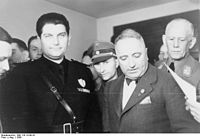- Tullio Cianetti
-
 Tullio Cianetti (left) with Robert Ley
Tullio Cianetti (left) with Robert Ley
Tullio Cianetti (born 20 August 1899 in Assisi – died 8 April 1976 in Maputo) was an Italian fascist politician who was well known for his work with the syndicates.
The son of a farmer, Cianetti was conscripted in 1917 and served as a lieutenant in the Italian Army until 1921.[1] Returning to Assisi, he worked as a teacher, whilst also helping to found the fascio in the town, becoming secretary in 1922.[1] He was moved to Terni to organise the syndicate before being appointed regional secretary for syndicates in Umbria in 1924.[1] The same year he stepped away from fascism for a time following the death of Giacomo Matteotti and suspicion began to arise that he was too left-wing.[1] However by 1925 he had returned as secretary of syndicates in Syracuse, before going on to hold similar roles in Carrara, Messina, Matero and Treviso.[1]
In 1931 he was made secretary of the national federation of miners and quarrymen and in this role agitated for higher wages.[1] However, despite his tendency to sometimes clash with the government he continued to rise in influence, serving as secretary of the Fascist Confederation of Industrial Workers' syndicates and Vice-President of the Institute of Social Assurance.[1] As head of the Confederation, Cianetti concluded a deal with Robert Ley in 1937 to allow Italian workers to go to Nazi Germany for employment.[2] Such was the regard with which he was held by the leaders of the German Labour Front that the main Volkswagen factory even had a leisure complex called Cianetti Hall in his honour.[3]
Cianetti's rise continued when he was appointed to the Fascist Grand Council in November 1934 and 1939 was made undersecretary of corporations.[1] He reached his zenith in April 1943 when he became Minister of Corporations.[1] However his dissident tendencies continued as Cianetti voted in favour of Dino Grandi's motion to remove Mussolini, after Grandi had told him that all he was doing was arranging for the king to share the burden of government with Mussolini.[4] Cianetti wrote to Il Duce to apologise immediately afterwards.[1]
Cianetti was one of those fascists tried along with Galeazzo Ciano in the Verona trial of 8–10 January 1944, although of all the defendants he was the only one spared execution, sentenced instead to thirty years imprisonment.[5] The letter of apology he had written to Mussolini saved him from the death penalty.[6] Following the liberation he escaped imprisonment and went into exile in Mozambique.[1]
References
- ^ a b c d e f g h i j k A.T. Lane, Biographical Dictionary of European Labor Leaders, Volume 1, 1995, p. 205
- ^ Shelley Baranowski, Strength Through Joy: Consumerism and Mass Tourism in the Third Reich, 2007, p. 136
- ^ Michael Burleigh, Confronting the Nazi Past: New Debates on Modern German History, 1996, p. 41
- ^ Philip Morgan, The Fall of Mussolini, Oxford University Press, 2007, p. 15
- ^ Ray Moseley, Mussolini: The Last 600 Days of Il Duce, p. 77
- ^ Nicholas Farrell, Mussolini: A New Life, London: Phoenix, 2004, p. 441
Categories:- 1899 births
- 1976 deaths
- Expatriates in Mozambique
- Government ministers of Italy
- Italian exiles
- Italian fascists
- Italian military personnel of World War I
- Italian trade unionists
- People from Assisi
Wikimedia Foundation. 2010.
